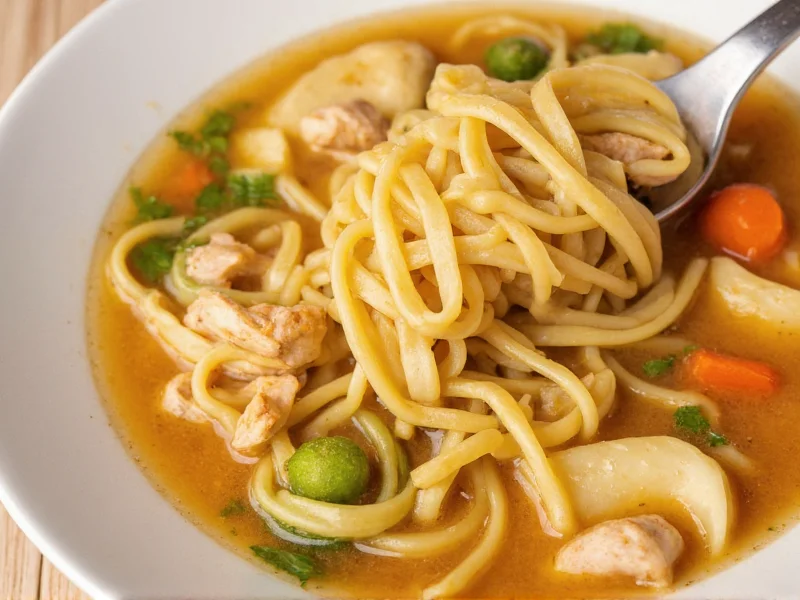When preparing classic chicken noodle soup, selecting the right noodle variety significantly impacts both texture and overall enjoyment. The ideal noodles should hold their structure during cooking and storage while complementing the soup's flavor profile. Egg noodles remain the traditional choice for good reason—they contain egg which helps them maintain integrity in liquid environments better than standard pasta.
Traditional Noodle Options for Chicken Soup
Egg noodles represent the gold standard for chicken noodle soup preparation. Their composition provides several advantages:
- Wide egg noodles - Offer substantial texture and hold up exceptionally well to reheating
- Medium egg noodles - Provide balanced texture without overwhelming the broth
- Extra fine egg noodles - Create a more delicate soup experience, ideal for lighter broths
The egg content in these noodles creates a protective barrier that prevents rapid absorption of liquid, maintaining their al dente quality even after sitting in broth for extended periods. This makes them particularly suitable for meal prepping chicken noodle soup recipes that require storage.
Alternative Noodle Choices
While traditional egg noodles remain the preferred option, several alternatives work well depending on dietary needs and flavor preferences:
| Noodle Type | Best For | Cooking Tip |
|---|---|---|
| Ditalini pasta | Thicker broths, chunky soups | Cook separately to prevent starch clouding broth |
| Orzo | Creamy chicken soups | Add late in cooking to avoid mushiness |
| Rice noodles | Gluten-free versions | Soak rather than boil to maintain texture |
| Vermicelli | Lighter Asian-inspired variations | Add just before serving |
Noodles to Avoid in Chicken Soup
Certain noodle varieties simply don't perform well in chicken noodle soup applications. These include:
- Angel hair pasta - Becomes mushy within minutes in hot broth
- Fresh pasta - Absorbs too much liquid and breaks down quickly
- Lasagna noodles - Too large and requires pre-cooking that alters texture
- Whole wheat pasta - Can become unpleasantly gummy in liquid
These varieties either disintegrate too quickly or develop undesirable textures when submerged in broth for extended periods. When searching for what noodles to use in chicken noodle soup, these options generally produce disappointing results.
Perfecting Noodle Texture in Soup
Achieving the ideal noodle texture requires attention to cooking technique. For best results with chicken soup noodle types:
- Cook noodles separately from the broth whenever possible
- Add noodles to individual bowls rather than the entire pot
- Undercook noodles by 1-2 minutes compared to package directions
- Allow noodles to finish cooking in the hot broth (carryover cooking)
- Store noodles and broth separately for meal prep versions
These techniques prevent the common problem of noodles becoming overly soft or absorbing too much broth. When preparing homemade chicken noodle soup with noodles, this approach maintains distinct textures between components.
Storage Considerations for Noodle Soup
If you're making chicken noodle soup ahead of time, proper storage technique affects noodle quality significantly. The best practice for storing chicken noodle soup with noodles involves:
- Keeping noodles and broth in separate containers
- Adding a teaspoon of oil to the noodle container to prevent sticking
- Reheating broth first, then adding noodles
- Refreshing stored noodles with a splash of water when reheating
This method preserves the integrity of the noodles, preventing the common issue of soup becoming too thick or noodles turning to mush during storage. When searching for how to keep noodles from getting soggy in chicken noodle soup, this separation technique proves most effective.
Frequently Asked Questions
What's the best noodle for chicken noodle soup that won't get mushy?
Wide egg noodles provide the best texture retention in chicken noodle soup. Their egg content creates a protective barrier that prevents rapid liquid absorption. Cook them separately and add to individual bowls just before serving for optimal texture that won't get mushy, even when stored.
Can I use regular pasta instead of egg noodles in chicken soup?
Yes, you can substitute certain pasta shapes like ditalini or small shells, but they behave differently than egg noodles. Regular pasta absorbs more broth and becomes softer faster. For best results with regular pasta in chicken noodle soup, cook it al dente separately and add to bowls just before serving to prevent over-softening.
How do I prevent noodles from soaking up all the broth?
To prevent noodles from absorbing too much broth in chicken noodle soup, cook them separately and add to individual servings rather than the entire pot. Store noodles and broth separately when meal prepping. When reheating, warm the broth first, then add the noodles to maintain proper soup-to-noodle ratio and prevent broth depletion.
What gluten-free noodles work well in chicken noodle soup?
Rice noodles and certain gluten-free pasta blends work best for gluten-free chicken noodle soup. Look for varieties specifically formulated to hold texture in liquids. Soak rice noodles rather than boiling them, and undercook gluten-free pasta by 2-3 minutes compared to package directions since they continue cooking in the hot broth.
Should I cook noodles directly in the soup or separately?
Cooking noodles separately produces superior results for chicken noodle soup. This prevents starch from clouding the broth and allows precise control over noodle texture. Add pre-cooked noodles to individual bowls just before serving to maintain ideal texture. This technique works particularly well when preparing chicken noodle soup with store-bought broth.











 浙公网安备
33010002000092号
浙公网安备
33010002000092号 浙B2-20120091-4
浙B2-20120091-4